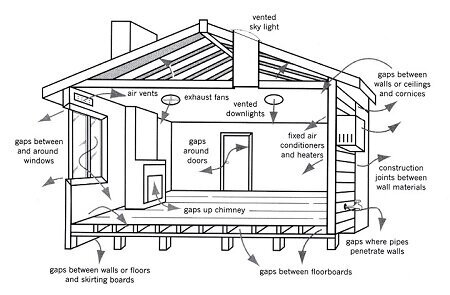Air leakage testing.
Air leakage occurs when air leaves or enters a house uncontrollably through gaps, cracks and openings in the building envelope. Properly sealing the air gaps in your home’s building envelope can significantly reduce your heating and cooling costs, improve the building’s durability, and create a healthier indoor environment for you and your family.
You may already know where some air leakage occurs in your home, for example obvious spots such as under and around external doors - but to properly air seal your home you’ll need to find the less obvious or hidden gaps.
We use a blower door test which is the only way to thoroughly locate and accurately measure the air leakage in your home. A blower door test carefully depressurises your home to measure the airtightness and help locate air leakage sites.
While using a blower door, many large leaks will be detectable simply by feeling with your hands. However, the ideal technique for locating areas of air leakage is to use a thermal imaging camera. This involves performing two infrared scans from inside the building; one before turning on the blower door and one after the blower door has depressurised.
Keep reading to learn more about blower door testing, air leakage, ventilation and moisture control. Fees for our air leakage testing can be found here.
Blower door testing
A blower door is a diagnostic tool designed to measure the airtightness of buildings and to help locate air leakage sites. It includes four components: a calibrated fan, an expandable door-panel system, a sensitive gauge to measure fan flow and building pressure, and tailored computer software.
The fan is sealed into an exterior doorway with the door-panel system and then used to draw air out of the building, creating a pressure difference between inside and outside. This pressure difference causes air from outside, at higher pressure, to move into the building through all the gaps in the building envelope.
The tighter the building (fewer gaps and cracks), the less fan speed needed to create a change in building pressure. The pressure gauge and computer regulate and record the airflow and pressure differences.
We register our tests with the Air Tightness Testing & Measurement Association (ATTMA). ATTMA operates a registered testers scheme providing 3rd party accreditation to testing companies
Why does your home leak energy and money?
Air leakage and insufficient insulation are the biggest culprits.
Sadly, many Australian homes are poorly sealed at the time of construction and have plenty of gaps right from the start. As your home ages, cracks can develop along the walls, window architraves and through the roof or sub-floor space. Additional leaks can be created by recessed lighting, ducting, plumbing and electrical penetrations and anything else that makes a hole through the internal lining of your home. Uncontrolled air leakage also compromises the effectiveness of other energy-efficiency measures such as new heating systems, window dressing and double glazing.
The majority of Canberra homes experience between 15-25 air changes per hour (ACH) at 50 Pa. However the air leakage standard introduced in the UK in 2006 aims for less than 10 ACH at 50 Pa, and we believe this is what we should also be aiming for in the Canberra climate.
In addition, many older houses lack insulation in the walls and under the floor, and have inadequate insulation in the ceiling.
Partner in crime
It is important to note that air sealing alone cannot replace the need for proper insulation to reduce heat flow through your home’s building envelope. Together, air sealing and insulation are the keys to an energy efficient and comfortable home. One without the other just doesn’t make sense - a tightly sealed (and properly ventilated) house that lacks insulation OR a well-insulated house that leaks air like a sieve, will still be unnecessarily uncomfortable and expensive to live in.
Read more about insulation and our thermal imaging service here.
Is air leakage the same as ventilation?
It is important not to confuse air leakage with ventilation. Air leakage is random and uncontrolled. Ventilation is for the specific and planned purpose of exhausting stale or moist air or bringing in fresh air.
Many people wrongly dismiss gaps and cracks in the building envelope as harmless, or even healthy, sources of fresh air. In actual fact, contaminated air (carrying chemical fumes, dust, pollen, mould spores and other allergens) can potentially enter your home through these gaps and cause health problems.
During cold or windy weather, too much air enters and leaves a leaky house making it very draughty and uncomfortable, not to mention very expensive to heat.
A leaky building envelope can also lead to moisture and maintenance problems - water vapour leaks into wall or roof spaces where it is much cooler and can condense, wetting insulation and potentially causing structural damage.
Controlled ventilation is the key to energy efficiency, indoor air quality and building durability. It is achieved by physically opening windows, switching on specially positioned exhaust fans, or using larger and more complex mechanical ventilation systems (standard practice in modern homes in the cold climates of Europe and North America). Random infiltration, or air leakage, should not be considered acceptable natural ventilation because it is not controlled or filtered.
The recommended strategy in both new and old homes is to reduce air leakage as much as possible and to provide controlled ventilation (including proper extraction of moist air) as needed.
How are air leakage and moisture control linked?
Thorough air sealing and well-installed insulation will help prevent moisture problems in your home. Proper ventilation, such as externally ducted exhaust fans to extract moist air in high humidity areas such as bathrooms, should also be part of a moisture control strategy.
Moisture moves in and out of a home in three ways:
with air currents
by diffusion through materials
by heat transfer.
Air movement alone accounts for more than 98% of all water vapour movement into building cavities. Air naturally moves from high-pressure areas to low-pressure areas by the path of least resistance, generally through any available gap in the building envelope. Moisture transfer by air currents happens quickly, and often invisibly and silently. Carefully and permanently sealing air leaks is a very effective moisture control strategy.
The other two driving forces - diffusion through materials and heat transfer - are much slower processes. Most common building materials slow moisture diffusion to a large degree, although they never stop it completely. Insulation also helps reduce heat transfer or flow.
What does the research say?
Overseas research shows, and standards recognise, that air leakage control is the most effective method of achieving direct energy savings. Australian buildings leak 2-4 times as much air as North American or European buildings, suggesting a tremendous opportunity for energy savings in Australia. ¹
Air leakage can account for 30% or more of a building’s heating and cooling costs. ²
Reducing air leakage can significantly cut energy bills and reduce greenhouse gas emissions. ³ ⁴
Insulating materials, such as batt or loose-fill products, do not seal against air leakage. ⁵
Uncontrolled air leakage compromises the effectiveness of other, more expensive, energy efficiency measures such as new heating systems, window dressing and double glazing.
References
¹ Australian Government DEWHA (2008), Your Home: Technical Manual www.yourhome.gov.au/technical/fs47.html
² US Department of Energy, Office of Building Technology apps1.eere.energy.gov/buildings/publications/pdfs/building_america/26446.pdf
³ US Department of Energy (2005), A Consumer’s Guide to Energy Efficiency and Renewable Energy, apps1.eere.energy.gov/consumer/your_home/insulation_airsealing/index.cfm/mytopic=11240
⁴ ACT Government (2003), Outreach Energy and Water Efficiency Program Case study report – Sect. 3.3 p14-15 http://www.environment.act.gov.au/__data/assets/pdf_file/0010/581608/Outreach_Energy_and_Water_Efficiency_program.pdf
⁵ US Department of Energy (2005), A Consumer’s Guide to Energy Efficiency and Renewable Energy, apps1.eere.energy.gov/consumer/your_home/insulation_airsealing/index.cfm/mytopic=11250



